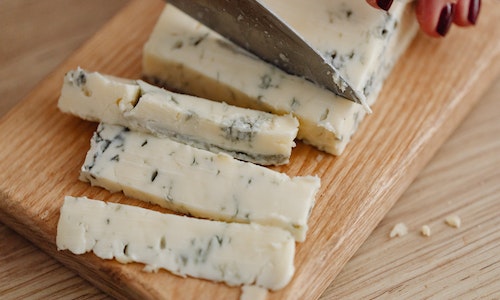The appearance of mold on any item of food is usually reason enough to throw the item away for fear of becoming Ill if it is eaten.
However, for some produce, mold is not only perfectly edible but actually plays an important role in developing both its flavor and texture.
In this article, we will be discussing why Gorgonzola has mold, the types of mold commonly found on blue cheese , how to tell good mold from bad, and a whole heap more, so keep reading!
, how to tell good mold from bad, and a whole heap more, so keep reading!

Why does Gorgonzola have mold?
As we discussed in the intro, mold on food is usually seen as a bad thing, so why does Gorgonzola have mold in it in the first place?
Blue cheeses, such as Stilton, Roquefort (and of course Gorgonzola), are created in a different manner to other hard cheeses like cheddar.
The mold found in blue cheeses is injected into the curds whilst they are developing in order to ensure the mold creates “veins” throughout the cheese.
The veins these molds create gives a unique texture and flavor profile that cannot be achieved with any other method, and the strains used are entirely safe to consume.
What types of mold are found on Gorgonzola?
The type of mold that is injected into curds during the process of creating Gorgonzola is called Penicillium roqueforti. This is known as a saprotrophic fungus, in the same genus as pennicilium, one of the most common mold strains found throughout the world.
This strain of mold is not harmful to humans, as it does not produce toxins known as mycotoxins. Without mycotoxins, the mold does not cause the same gastrointestinal and health complaints that other strains of mold can.
In fact, not only is Penicillium roqueforti not harmful to humans, it actually carries several benefits, including anti-inflammatory properties that can aid in decreasing blood pressure and may limit cholesterol accumulation.
Is mold on Gorgonzola bad?
This is where the topic of mold on Gorgonzola has the potential to become slightly clouded, as whilst we have discussed that the mold found within Gorgonzola is entirely deliberate, mold found growing on the cheese after purchase may be a different matter entirely.
Depending on how the cheese was stored (more on that later), other strains of mold can begin to grow on its surface, some of which have the potential to cause harm to humans.
As a general rule, molds that are white, black, green, orange, or red all have the potential for being hazardous to health, as many of these strains have the ability to produce the mycotoxins that we discussed earlier.
If you notice any types of mold in these color variations that have a powdery or cobweb-type structure, it should not be consumed, as you will have few options with regard to understanding what particular strain you are dealing with and whether it is safe to eat.
Is it safe to eat Gorgonzola mold?
Yes, it is completely safe to eat the mold found within your Gorgonzola, which is to say the blue veins found throughout the cheese.
As discussed, other forms of mold found growing on the surface of the cheese have the potential to produce mycotoxins, so if any molds are found growing on the cheese after you purchase it, it should not be consumed.
after you purchase it, it should not be consumed.
Can moldy Gorgonzola be saved?
In some instances, moldy Gorgonzola can be saved. As the mold is on the exterior, it can be cut off and the rest of the cheese saved.
An important aspect of this is that you must ensure that the mold has not penetrated into the interior of the cheese. If it has not, you can safely cut away an inch off the surface of the cheese to remove the mold. It is very important that you make sure the knife is cleaned after each cut, as pieces of mold attached to the knife can find their way into deeper areas of the cheese, spreading yet more mold.
How long does Gorgonzola last?
Gorgonzola has a long shelf life as long as it is stored correctly (more on this later). When stored in a refrigerator under the correct conditions, Gorgonzola can be expected to last 3 to 4 weeks.
Even if the cheese is past its sell-by date, it can still be edible, simply cut away any signs of mold or deterioration on the surface of the cheese as explained above, the cheese underneath will not be damaged and can still be eaten.
Shredded or crumbled Gorgonzola has a shorter shelf life, as more of the cheese’s surface is exposed and can grow mold. If after several weeks in the refrigerator you notice mold growing on shredded or crumbled Gorgonzola, it should be thrown away, as it is no longer safe to consume.
To spot when Gorgonzola has gone bad, take notice of the texture, color, and smell of the cheese. Bad Gorgonzola will have a hardened texture, as well as become dry, have a darker coloration, and will begin to have an unpleasant smell.
How to store Gorgonzola to prevent bad molds growing
In order to prolong the shelf life of Gorgonzola and to prevent mold formation, store it in a refrigerator at all times.
To keep its flavor and texture for as long as possible, wrap the cheese in parchment paper and then an additional layer of plastic wrap. The parchment paper will absorb moisture and prolong mold growth from occurring.
The temperature of the refrigerator should be kept between 4 and 6 degrees Celsius (39 to 43 Fahrenheit). Check your refrigerator for any signs of damage to the casket or thermostat to ensure the fridge remains at this temperature consistently.
Can you freeze Gorgonzola to prevent mold?
Absolutely, freezing Gorgonzola is an option that will extend its usability considerably and prevent mold growth from occurring.
Whilst freezing Gorgonzola will prevent deterioration, after 6 months it will begin to lose its flavor and texture. It is best therefore to be consumed before this date. However, if this does not concern you, you can safely keep Gorgonzola cheese frozen indefinitely for whenever you need it.
Conclusion
In today’s article, you will have learned about why mold is used to make Gorgonzola cheese, how it can be stored correctly to prevent unwanted types of mold growth and how to save an already moldy piece.
Here are a few takeaways:
Gorgonzola cheese is made with a specific strain of mold to enhance its flavor and texture profiles. Stored correctly it can last up to 3-4 weeks in the refrigerator and indefinitely if frozen. The mold within Gorgonzola is safe to eat, whereas any signs of mold growing on the editor should be cut away, or the cheese thrown out if severely affected by mold.

